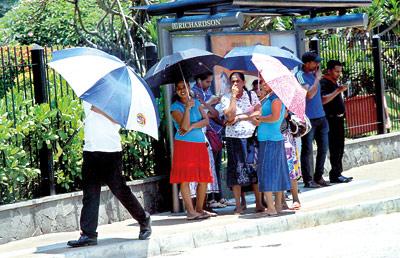News
Heatstroke: A possible hazard with the current weather conditions

Umbrellas a must these days. Pic by Indika Handuwala
Heat stroke results from prolonged exposure to high temperatures and with the influence of global warming it is predicted that the incidence of heatstroke and its fatalities will also become more prevalent. Heat stroke often occurs as a progression from milder heat-related illnesses such as heat cramps, heat syncope (fainting), and heat exhaustion. Heatstroke is the most severe form of the heat-related illnesses and is defined as the body temperature reaching higher than 41.1°C (106°F).
Two forms of heatstroke exist and both happen in hot conditions: Exertional heatstroke (EHS) generally occurs in people who engage in strenuous physical activity for a prolonged period in a hot environment while nonexertional heatstroke (NEHS) more commonly affects elderly people, those who are chronically ill and young children. Both types of heatstroke are associated with high morbidity and mortality especially when cooling therapy is delayed.
Despite wide variations in environmental temperature, humans and other mammals can maintain a constant body temperature by balancing heat gain with heat loss. When the human body gets too hot, natural reaction of it is to perspire and sweat to cool it. Evaporation of the sweat produced on the surface of the body is the cooling process which effectively reduces the body temperature. If the sweat produced is not able to evaporate the body cannot bring down its temperature and when heat gain overwhelms the mechanisms of heat loss, the body temperature rises potentially leading to heatstroke.
When the atmospheric moisture content (relative humidity) is high, the rate of evaporation of the sweat produced from the body decreases. Therefore people feel warmer in humid conditions and when relative humidity decreases the rate of perspiration increases making them to feel cooler. Heat and discomfort index which is also known as the apparent temperature is what the temperature feels like to the human body when relative humidity is combined with the air temperature. Considering that in the recent weeks Sri Lanka is experiencing extreme weather conditions it has become important to be aware of the concept of heat index and the medical conditions related to it.

Heat index could be measured by using the chart displayed here and applying the air temperature and the relative humidity. For example, if the air temperature is 32C and the relative humidity is 75%, the heat index will be 46C. When the relative humidity is high the apparent temperature can actually be higher than the air temperature. The heat index values in the chart are for shady locations and if you are exposed to direct sunlight the heat index value can be increased by up to 6C. As shown in the table here, heat indices are related to medical symptoms and indices exceeding 54 C can lead to dangerous heat disorders.
The other table shows how the heat index values are calculated for the temperatures and the humidity experienced during three consecutive days during the last week in Colombo.
One can observe that during all three days except at night, the heat index has been in the range of 41-54C which is in the Danger zone where heat cramps and heat exhaustion are likely and heat stroke is probable with continued physical activity. If you are exposed to direct sunlight the heat index value can increase by up to 6C, making it close to heat stroke level even without any activity.
 People who are most susceptible to heatstroke are:
People who are most susceptible to heatstroke are:
- Infants
- The elderly (often with associated heart diseases, lung diseases, kidney diseases, or who are taking medications that make them vulnerable to dehydration and heat strokes)
- Athletes
- Individuals who work outside and physically exert themselves under the sun
- Children or infants left in enclosed environments wearing tight clothing or wrapped with cloth.
A person experiences symptoms of heat exhaustion before progressing to heatstroke. Signs and symptoms of heat exhaustion include: nausea, vomiting, fatigue, weakness, headache, muscle cramps and aches, and dizziness. Therefore some of the non-specific symptoms people are experiencing in the past few weeks may be due to heat exhaustion.
However, some people can develop symptoms of heatstroke suddenly and rapidly without warning. Common symptoms and signs of heat stroke are high body temperature, hot red or flushed dry skin with absence of sweating, rapid pulse, difficulty in breathing, strange behaviour, hallucinations, confusion, agitation, disorientation, convulsions and coma. If unattended or undiagnosed, heatstroke may even cause death.
 The most important measures to prevent heat strokes are to avoid becoming dehydrated and to avoid vigorous physical activities in hot and humid weather under direct sunlight. Your body will need replenishment with electrolytes such as sodium and fluids if you sweat excessively or perform vigorous activity in the sunlight for prolonged periods.
The most important measures to prevent heat strokes are to avoid becoming dehydrated and to avoid vigorous physical activities in hot and humid weather under direct sunlight. Your body will need replenishment with electrolytes such as sodium and fluids if you sweat excessively or perform vigorous activity in the sunlight for prolonged periods.
If you are compelled to perform physical activities in this hot weather, drink plenty of fluids but avoid alcohol and caffeine containing soft drinks and tea which may lead to dehydration. Take frequent breaks under a shade to hydrate yourself and always wear light-colored, lightweight, loose clothes. Among older children and teens, heatstroke or heat-related illness is a risk if they do sporting activities exposed to direct sunlight and therefore it is essential to avoid such activity especially from 10 a.m. to 4 p.m. Air-conditioning lowers the risk of heat stroke as it brings down environmental temperature and humidity.
 If you suspect someone is suffering from heatstroke, take the victim to a shady area, remove clothing, and apply cool or tepid water to the skin. Then fan to promote evaporation and place ice packs under the armpits and groin to bring down the body heat. If he is able to drink liquids, give him cool water or cool beverages and take him to the nearest hospital. These immediate first aid measures may even prevent death from heat stroke.
If you suspect someone is suffering from heatstroke, take the victim to a shady area, remove clothing, and apply cool or tepid water to the skin. Then fan to promote evaporation and place ice packs under the armpits and groin to bring down the body heat. If he is able to drink liquids, give him cool water or cool beverages and take him to the nearest hospital. These immediate first aid measures may even prevent death from heat stroke.
(The writer is a Consultant Paediatrician and Clinical Allergist. He is a member of the Environmental Chapter of the International Paediatric Association.)

